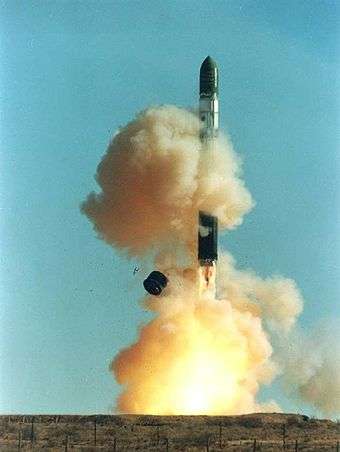Heavy ICBM

The R-36 Intercontinental Ballistic Missile
Heavy ICBM is a term that was created in the 1970s to describe a class of Soviet ICBMs (intercontinental ballistic missiles).[1] They were characterized by a heavy throw-weight of 5 to 9 metric tons, several times that of an LGM-30 Minuteman, and a length of over 35 meters, and were thus capable of delivering a large number of warheads in a single MIRV missile.
This term usually refers to R-36 (missile)/SS-9 Scarp,[2] R36 M/SS-18 Satan,[1][3] and the RS-28 Sarmat missiles.
Deliveries
The SS-9 was a silo-launched missile capable of delivering warheads of 5–18 megatons, with a range of up to 15,500 km.[4] These were then replaced by the similar SS-18, with payloads of 18–25 megatons. The silos used for launching were the same for both, once modified.
See also
References
- 1 2 Graham, Thomas, Jr.; Damien J. La Vera (2003). Cornerstones of Security: Arms Control Treaties in the Nuclear Era. University of Washington Press. pp. 336 et al. ISBN 9780295982960.
- ↑ "R-36 / SS-9 SCARP". www.fas.org. Retrieved 19 October 2012.
- ↑ "R-36M / SS-18 SATAN". www.fas.org. Retrieved 19 October 2012.
- ↑ "SS-9". www.missilethreat.csis.org. Retrieved 19 October 2012.
This article is issued from Wikipedia - version of the 11/25/2016. The text is available under the Creative Commons Attribution/Share Alike but additional terms may apply for the media files.